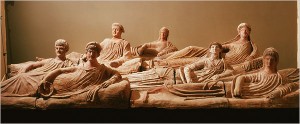Mitochondrial DNA tests comparing modern Tuscans to the Etruscans who used to live there before the Romans sort of swallowed them up indicate no relations between the current population and the original one.
”Some people have hypothesised that the most ancient DNA sequences, those from the Etruscan era, could contain errors or have been contaminated but tests conducted with new methods exclude this,” said David Caramelli of Florence University and Guido Barbujani of Ferrara University.
”The most simple explanation is that the structure of the Tuscan population underwent important demographic changes in the first millennium before Christ,” they said.
”Immigration and forced migration have diluted the Etruscan genetic inheritance so much as to make it difficult to recognise”.
On the other hand, comparisons with Medieval Tuscans indicate a clear genetic link to today’s Tuscans, which makes sense because there hasn’t been anything like the population upheaval in the past thousand years that there was in the couple of thousand before then.
That’s not to say there are no Etruscan descendants in the region. There may be some isolated population pockets that researchers just haven’t tested yet.
The town of Murlo, for instance, has already played a role in trying to pin down where the Etruscans might have come from. It’s a small hamlet which hasn’t seen much change over the millennia, so the residents’ mitochondrial DNA was tested to see if it matched other European strains.
Turns out they share their lineage with the Near East, not Europe, as do several other Tuscan hamlets, suggesting to researchers that Herodutus might have been right that the Etruscans migrated to Italy from Lydia in what is now Turkey.
For more information on the Etruscans, check out this site. It’s not the best designed website in the world, but it’s packed with great information and images.
